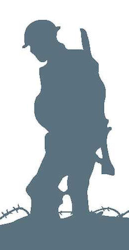Biography
Hamilton Osler was born in Bedmond in the winter of 1899. He was one of six sons and one daughter born to Frank Osler and Jane (nee Phillips). Over the years Frank worked as a Railway Clerk (1891), an Attendant at the Asylum (1901) and a General Labourer (1911). Three of his sons served in the Great War.
Hamilton enlisted at Watford, and in June 1917 he was recorded in the Abbots Langley Parish Magazine Roll of Honour serving with a Reserve Battalion. It is not known exactly when he completed his training, but by January 1918 he had been transferred to the 2/4th Battalion of the Queen’s Royal West Surrey (QRWS) Regiment. In July 1918 the QRWS’s moved to the Reims Front towards the closing weeks of the German Spring Offensive. The battalion was in action on 23rd July, and then spent a quieter period in the Front Line until on 29th the battalion was once more called upon to attack the enemy. At 4.10am, together with French troops the battalion advanced at Grand Rosoy, to the west of Reims and south of Soissons, but was forced to withdraw and came under heavy bombardment. For the next two days the QRWS was subjected to heavy shelling, until at 4.00am on 1st August the British artillery responded to a gas bombardment with counter fire. At 4.45am the 2/4th QRWS left their trenches and advanced around 1,000 yards and took their objectives. French units passed through their lines and the anticipated German counter attack failed to materialise. However the enemy continued heavy machine gun fire and the War Diary recorded that they used the flamenwerfer (flame-thrower) to harass the British lines. Hamilton Osler was killed in action during this attack or in the ensuing counter fire on 1st August. It was much quieter over the next two days, and the QRWS collected and buried their dead, and cleared the battlefield before the battalion was withdrawn by motor lorry on 4th August. Hamilton’s remains were not recovered and he is commemorated on the Soissons Memorial, Aisne, France.
Hamilton’s death (together with Edwin Bertie Coles) was recorded in the Abbots Langley Parish Magazine in September 1918 – “We deeply lament t he loss of two more of our boys, both 19 years of age, and both sent out to the Front in March (1918) during the great German offensive, and belonging to that gallant body of British youth who Mr Lloyd-George said stopped and broke the power of the trained soldiers of Germany. Hamilton Clyde Osler belonged to Bedmond, which has sustained so many losses. Two of his brothers were in the Forces, of whom Clifton was killed, and Frank was discharged wounded, and now the third has been killed. We offer to the father and mother of these gallant boys our sincerest sympathy”.
Hamilton Osler is commemorated on the Abbots Langley War Memorial. He is also commemorated on the War Memorial at the Church of the Ascension at Bedmond. Edwin Bertie Coles was killed in action in July, and was also commemorated on the Soissons Memorial. Hamilton's brother Clifton was also killed.
War gratuity of £5 10s and arrears of £6 5s 6d paid to his father.



